Abstract
When the content of cyclic AMP (cAMP) was compared in livers of a series of congenic mouse strains differing at the H-2 locus, significant variation in concentration of cAMP per unit wet weight was found among strains, and also for animals of a given strain with increasing age. For a given age, from 8 to 22 weeks, cAMP levels in liver of H-2a and H-2b genotype animals were significantly higher than that in liver of H-2k type animals. This difference was seen whether the H-2 gene was on the genetic background of strain C57BL/10, C3H, or A. Levels of cAMP in livers of H-2d animals were between those of H-2a and H-2k animals.
Full text
PDF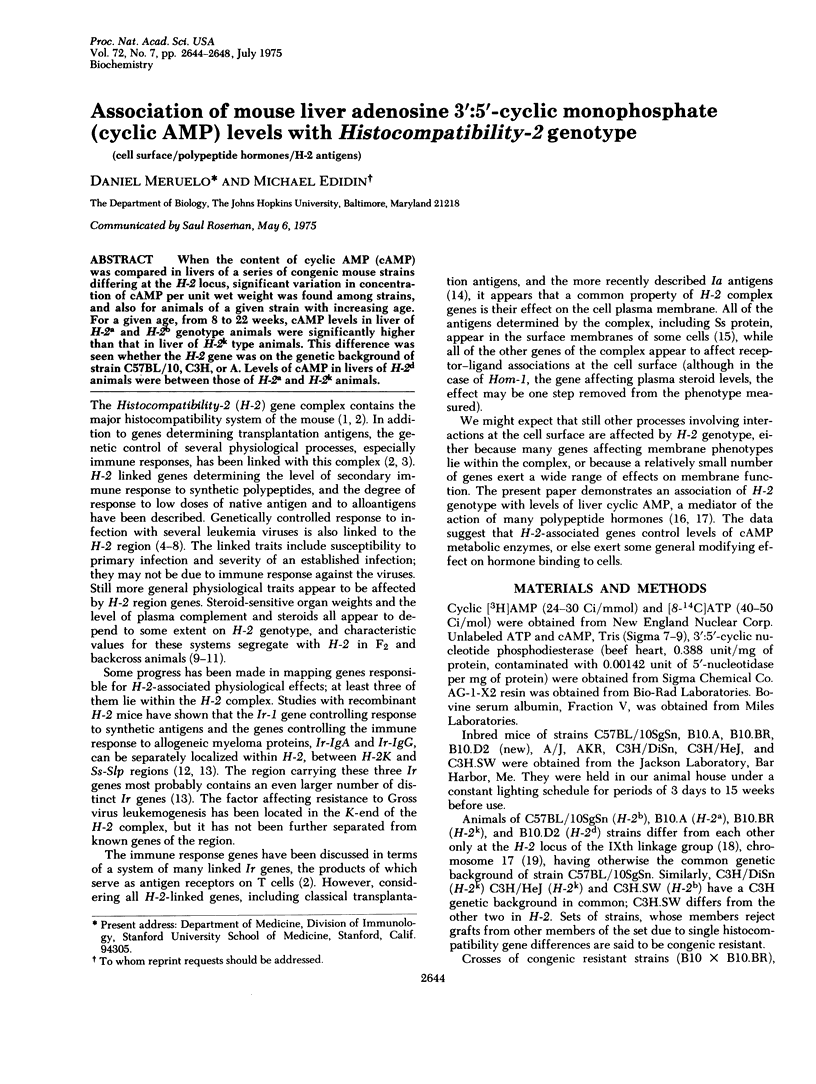
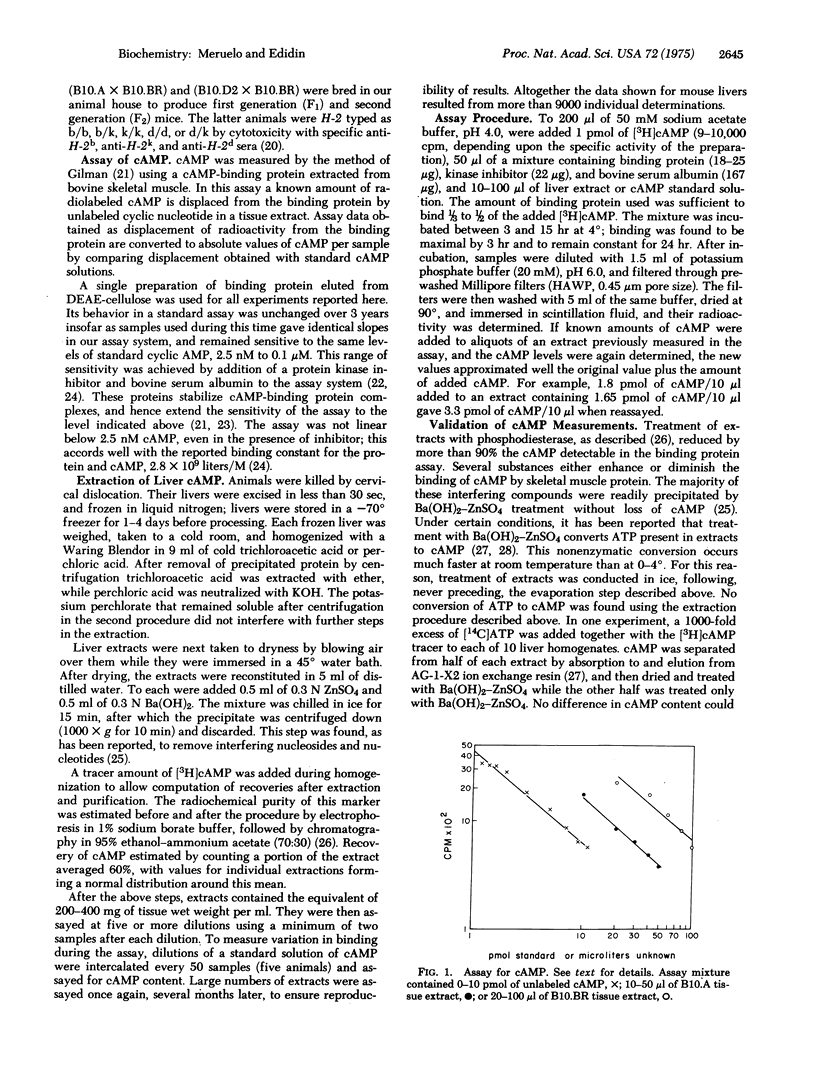
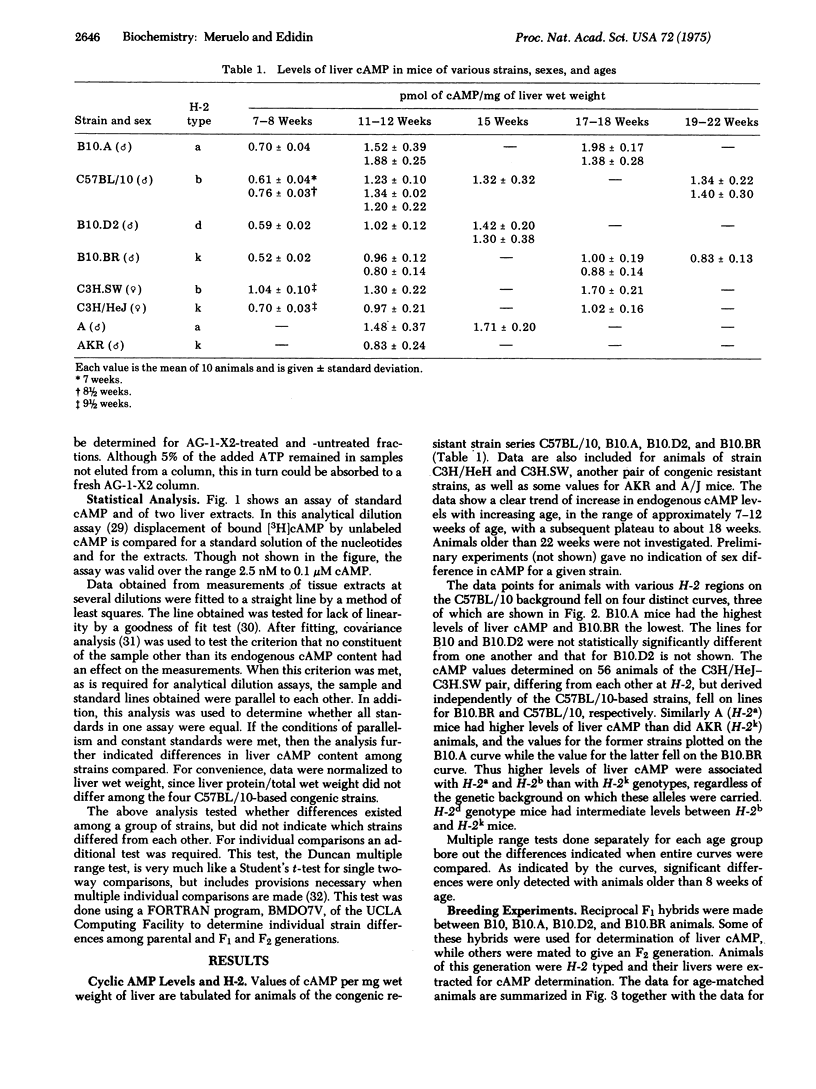
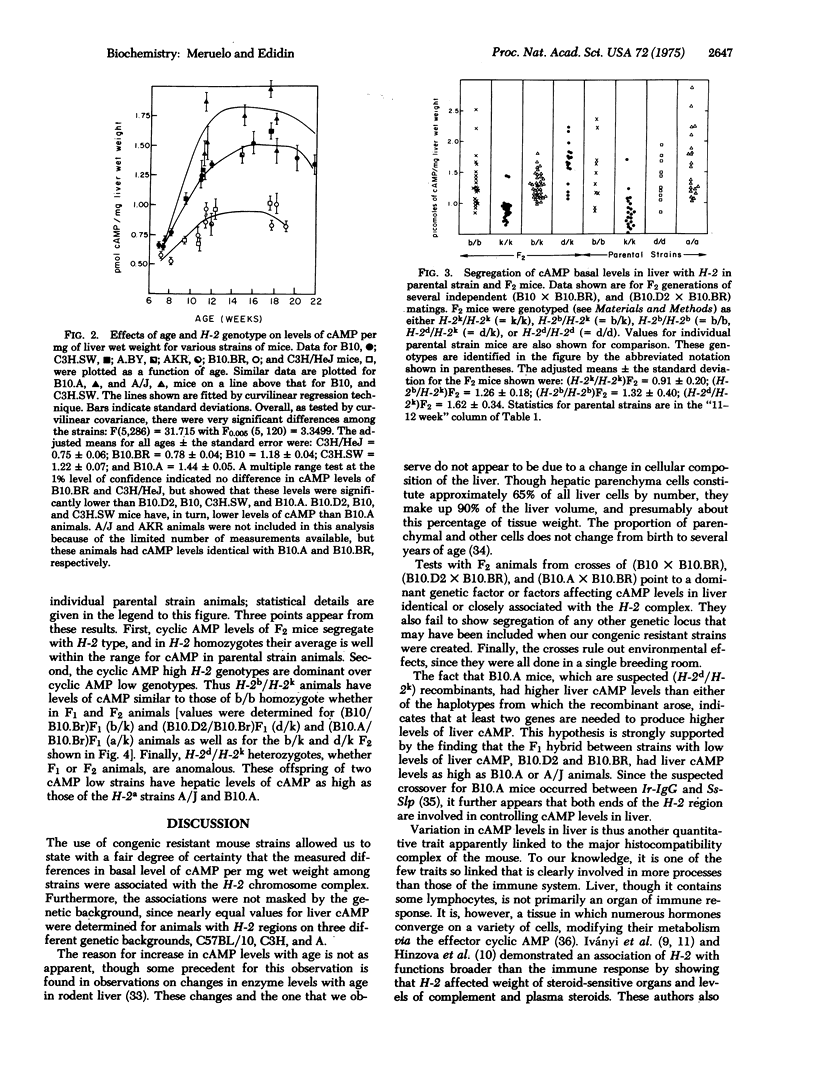
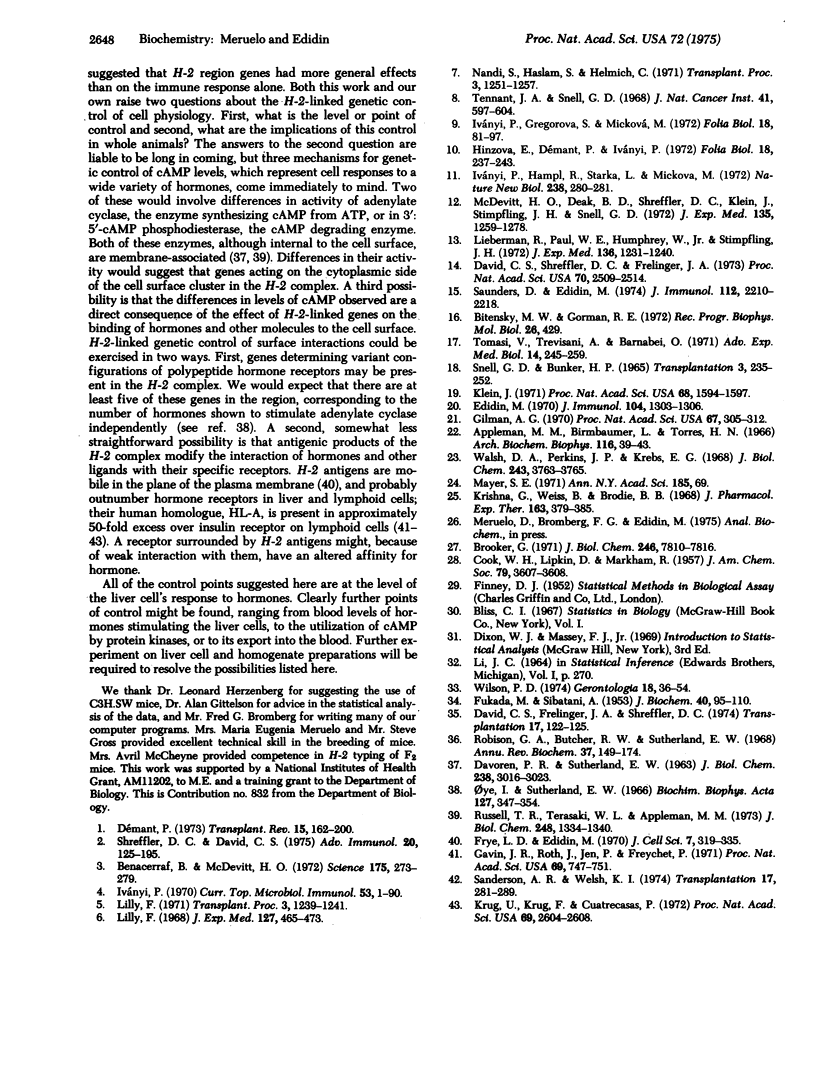
Selected References
These references are in PubMed. This may not be the complete list of references from this article.
- Appleman M. M., Birnbaumer L., Torres H. N. Factors affecting the activity of muscle glycogen synthetase. 3. The reaction with adenosine triphosphate Mg++, and cyclic 3'5'-adenosine monophosphate. Arch Biochem Biophys. 1966 Sep 26;116(1):39–43. doi: 10.1016/0003-9861(66)90009-9. [DOI] [PubMed] [Google Scholar]
- Benacerraf B., McDevitt H. O. Histocompatibility-linked immune response genes. Science. 1972 Jan 21;175(4019):273–279. doi: 10.1126/science.175.4019.273. [DOI] [PubMed] [Google Scholar]
- Brooker G. High pressure anion exchange chromatographic measurement of cyclic adenosine 3',5'-monophosphate and cyclic (14C) adenosine monophosphate specific activity in myocardium prelabeled with (14C) adenosine. J Biol Chem. 1971 Dec 25;246(24):7810–7816. [PubMed] [Google Scholar]
- DAVOREN P. R., SUTHERLAND E. W. THE CELLULAR LOCATION OF ADENYL CYCLASE IN THE PIGEON ERYTHROCYTE. J Biol Chem. 1963 Sep;238:3016–3023. [PubMed] [Google Scholar]
- David C. S., Frelinger J. A., Shreffler D. C. New lymphocyte antigens controlled by the Ir-IgG region of the H-2 gene complex. Transplantation. 1974 Jan 1;17(1):122–125. [PubMed] [Google Scholar]
- David C. S., Shreffler D. C., Frelinger J. A. New lymphocyte antigen system (Lna) controlled by the Ir region of the mouse H-2 complex. Proc Natl Acad Sci U S A. 1973 Sep;70(9):2509–2514. doi: 10.1073/pnas.70.9.2509. [DOI] [PMC free article] [PubMed] [Google Scholar]
- Démant P. H-2 gene complex and its role in alloimmune reactions. Transplant Rev. 1973;15:162–200. [PubMed] [Google Scholar]
- Edidin M. A rapid, quantitative fluorescence assay for cell damage by cytotoxic antibodies. J Immunol. 1970 May;104(5):1303–1306. [PubMed] [Google Scholar]
- Frye L. D., Edidin M. The rapid intermixing of cell surface antigens after formation of mouse-human heterokaryons. J Cell Sci. 1970 Sep;7(2):319–335. doi: 10.1242/jcs.7.2.319. [DOI] [PubMed] [Google Scholar]
- Gavin J. R., 3rd, Roth J., Jen P., Freychet P. Insulin receptors in human circulating cells and fibroblasts. Proc Natl Acad Sci U S A. 1972 Mar;69(3):747–751. doi: 10.1073/pnas.69.3.747. [DOI] [PMC free article] [PubMed] [Google Scholar]
- Gilman A. G. A protein binding assay for adenosine 3':5'-cyclic monophosphate. Proc Natl Acad Sci U S A. 1970 Sep;67(1):305–312. doi: 10.1073/pnas.67.1.305. [DOI] [PMC free article] [PubMed] [Google Scholar]
- Hinzová E., Démant P., Iványi P. Genetic control of haemolytic complement in mice: association with H-2. Folia Biol (Praha) 1972;18(4):237–243. [PubMed] [Google Scholar]
- Iványi P., Gregorová S., Micková M. Genetic differences in thymus, lymph node, testes and vesicular gland weights among inbred mouse strains. Association with the major histocompatibility (H-2) system. Folia Biol (Praha) 1972;18(2):81–97. [PubMed] [Google Scholar]
- Iványi P., Hámpl R., Stárka L., Micková M. Genetic association between H-2 gene and testosterone metabolism in mice. Nat New Biol. 1972 Aug 30;238(87):280–281. doi: 10.1038/newbio238280a0. [DOI] [PubMed] [Google Scholar]
- Iványi P. The major histocompatibility antigens in various species. Curr Top Microbiol Immunol. 1970;53:1–90. [PubMed] [Google Scholar]
- Klein J. Cytological identification of the chromosome carrying the IXth linkage group (including H-2) in the house mouse. Proc Natl Acad Sci U S A. 1971 Jul;68(7):1594–1597. doi: 10.1073/pnas.68.7.1594. [DOI] [PMC free article] [PubMed] [Google Scholar]
- Krishna G., Weiss B., Brodie B. B. A simple, sensitive method for the assay of adenyl cyclase. J Pharmacol Exp Ther. 1968 Oct;163(2):379–385. [PubMed] [Google Scholar]
- Krug U., Krug F., Cuatrecasas P. Emergence of insulin receptors on human lymphocytes during in vitro transformation. Proc Natl Acad Sci U S A. 1972 Sep;69(9):2604–2608. doi: 10.1073/pnas.69.9.2604. [DOI] [PMC free article] [PubMed] [Google Scholar]
- Lieberman R., Paul W. E., Humphrey W., Jr, Stimpfling J. H. H-2-linked immune response (Ir) genes. Independent loci for Ir-IgG and Ir-IgA genes. J Exp Med. 1972 Nov 1;136(5):1231–1240. doi: 10.1084/jem.136.5.1231. [DOI] [PMC free article] [PubMed] [Google Scholar]
- Lilly F. The effect of histocompatibility-2 type on response to friend leukemia virus in mice. J Exp Med. 1968 Mar 1;127(3):465–473. doi: 10.1084/jem.127.3.465. [DOI] [PMC free article] [PubMed] [Google Scholar]
- McDevitt H. O., Deak B. D., Shreffler D. C., Klein J., Stimpfling J. H., Snell G. D. Genetic control of the immune response. Mapping of the Ir-1 locus. J Exp Med. 1972 Jun 1;135(6):1259–1278. doi: 10.1084/jem.135.6.1259. [DOI] [PMC free article] [PubMed] [Google Scholar]
- Oye I., Sutherland E. W. The effect of epinephrine and other agents on adenyl cyclase in the cell membrane of avian erythrocytes. Biochim Biophys Acta. 1966 Oct 31;127(2):347–354. doi: 10.1016/0304-4165(66)90389-8. [DOI] [PubMed] [Google Scholar]
- Robison G. A., Butcher R. W., Sutherland E. W. Cyclic AMP. Annu Rev Biochem. 1968;37:149–174. doi: 10.1146/annurev.bi.37.070168.001053. [DOI] [PubMed] [Google Scholar]
- Russell T. R., Terasaki W. L., Appleman M. M. Separate phosphodiesterases for the hydrolysis of cyclic adenosine 3',5'-monophosphate and cyclic guanosine 3',5'-monophosphate in rat liver. J Biol Chem. 1973 Feb 25;248(4):1334–1340. [PubMed] [Google Scholar]
- SNELL G. D., BUNKER H. P. HISTOCOMPATIBILITY GENES OF MICE. V. FIVE NEW HISTOCOMPATIBILITY LOCI IDENTIFIED BY CONGENIC RESISTANT LINES ON A C57B 10 BACKGROUND. Transplantation. 1965 Mar;3:235–252. doi: 10.1097/00007890-196503000-00011. [DOI] [PubMed] [Google Scholar]
- Sanderson A. R., Welsh K. I. Properties of histocompatibility (HL-A) determinants. I. Site density of antigens of the two HL-A segregant series on peripheral human lymphocytes. Transplantation. 1974 Mar;17(3):281–289. [PubMed] [Google Scholar]
- Saunders D., Edidin M. Sites of localization and synthesis of Ss protein in mice. J Immunol. 1974 Jun;112(6):2210–2218. [PubMed] [Google Scholar]
- Shreffler D. C., David C. S. The H-2 major histocompatibility complex and the I immune response region: genetic variation, function, and organization. Adv Immunol. 1975;20:125–195. doi: 10.1016/s0065-2776(08)60208-4. [DOI] [PubMed] [Google Scholar]
- Tennant J. R., Snell G. D. The H-2 locus and viral leukemogenesis as studied in congenic strains of mice. J Natl Cancer Inst. 1968 Aug;41(2):597–604. [PubMed] [Google Scholar]
- Walsh D. A., Perkins J. P., Krebs E. G. An adenosine 3',5'-monophosphate-dependant protein kinase from rabbit skeletal muscle. J Biol Chem. 1968 Jul 10;243(13):3763–3765. [PubMed] [Google Scholar]
- Wilson P. D. Enzyme patterns in young and old mouse livers and lungs. Gerontologia. 1972;18(1):36–54. doi: 10.1159/000211918. [DOI] [PubMed] [Google Scholar]


